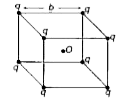A cube of side b has a charge q at each of its vertices. Determine the potential and electric field due to this charge array at the centre of the cube.
Here, we have to find the electric potential and electric field due to multiple charge so we have to apply superposition principle to calculate net electric field and potential
 Solution in Odia
Solution in Odia
Consider a cube of side b and its centre be O. The charge q is placed at each of the corners.
Side of the cube = b
Length of the main diagonal of the cube
=√b2+b2+b2=√3b
Distance of centre O from each of the vertices is
r=b√32 . . . (i)
Potential at point O due to one charge,
V=14πε0⋅qr
Potential at point O due to all charges placed at the vertices of the cube,
V.=8V=8×1×q4πε0r=8q×24πε0r=8q×24πε0⋅b√3 [from Eq, (i)]
=4q√3πε0b
The electric field due to one vertex is balanced by the electric field due to the opposite vertex because all charges are positive in nature. Thus, the resultant electric field at the centre O of the cube is zero.
Similar Questions
A cube of side b has a charge q at each of its vertices. Determine the potential and electric field due to this charge array at the centre of the cube.
View SolutionA cube of side b has a charge q at each of its vertices. Determine the potential and electric field due to this charge array at the centre of the cube.
View SolutionA cube of side b has a charge q at each of its vertices. Determine the potential and electric field due to this charge array at the centre of the cube.
View SolutionA cube of side b has a charge q at each of its vertices. Determine the potential and electric field due to this charge array at the center of the cube.
View SolutionA cube of side b has a charge g at each of its vertices. Determine the potential and electric field due to this charge array at the centre of the cube.
View SolutionA cube of side b has a charge q at each of its vertices. Determine the potential and electric field due to this charge array at the centre of the cube.
View SolutionA cube of side x has a charge q at each of its vertices. Determine the potential due to this charge array at the center of the cube.
View SolutionA cube of side b has a charge q at each of its vertices. Determine the electric field due to this charge array at the center of the cube.
View Solution
